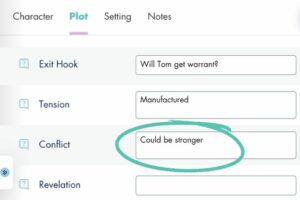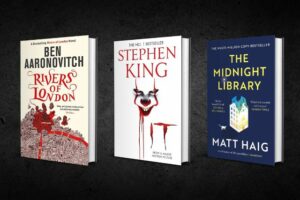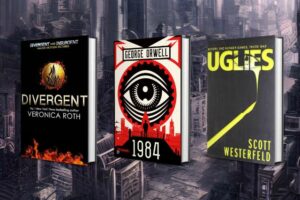
External conflict moves your story forward, and the question of how to write external conflict is a difficult one to answer.
This sounds like a simple concept, but it took me a long time to really understand what that means. I read all the craft books, attended all the webinars, and bought all the courses. And I thought I understood what conflict was…
Until I found Fictionary.
The way Fictionary breaks story elements down into their simplest form to help you tell stories readers love is what finally helped me grasp how to use conflict to engage readers.
What is External Conflict?
Ask Yourself: What is my Point of View Character’s Goal, and who or what is standing in their way of achieving it?
External conflict is:
Point of View Character Goal + Opposition = External Conflict
External conflict arises when your point of view character has a goal, and something or someone stands in the way of them achieving it. So, the key to conflict is an opposing (or antagonistic) force.
If they’re going to achieve their goal, your point of view character needs to engage with this opposing force and try to overcome it.
If there’s nothing opposing your point of view character, there’s no conflict.
And a lack of conflict bores readers.
Action: In every scene, make sure your point of view character has a goal. Then, make sure there’s something or someone opposing your protagonist. You want to make things difficult for them, because conflict drives stories forward. In the Fictionary Software, you can keep track of scenes that lack conflict, so you can improve them when you revise. Simply fill out the Conflict Story Element for each scene (on the Evaluate page), then view the Story Map (on the Visualise page) to track scenes you need to edit.

Definition of External Conflict
Conflict is an incompatibility or a disagreement. Conflict can be internal, within a person, or external, outside of a person.
So external conflict is any that occurs between a character and an external force. That external force could be another character, the environment, an object, the government, and more.
What’s the Difference Between Tension and Conflict?
Ask yourself: How can I use tension to build up to the conflict?
But, you cry, I’ve heard people talking about tension and conflict. What’s the difference?
That’s a brilliant question.
Tension is the threat of something bad happening, and conflict is the bad thing actually happening.
Imagine your point of view character walks alone at night, and they hear a twig snap behind them. They turn, and someone’s following them. They immediately worry. Who is the person following them? What do they want? Do they want to harm them?
That’s tension, because the point of view character is expecting a threat.
Then, imagine the bad thing actually happens. If the person following your protagonist attacks them, and force them to defend themselves, that’s conflict.
Action: In the Fictionary Software, we’ve split Tension and Conflict into two separate Story Elements. On the Evaluate Page, fill out the Tension and Conflict Story Elements. Then use the Story Map to track where you might need to improve the story. Keep the relationship between tension (the threat for something bad happening) and conflict (the bad thing happening) in mind. Check you’ve built up enough tension before you launch into the conflict.
PRO TIP: Every scene needs tension, because tension keeps readers in an anticipatory state, waiting for something to happen.
5 Types of External Conflicts in Literature

Ask Yourself: Have I included the right kind of conflict in my novel?
Broadly speaking, there are four types of external conflict writers use in fiction to keep readers flipping pages.
1. Character vs Character
The key to creating great character vs character conflict is making sure your protagonist and your major side characters are well developed. When you develop your characters well, they have clear goals, motivations, and beliefs.
And these goals, motivations, and beliefs are a gold mine for conflict.
If you can make sure your protagonist’s goals, motivations, and beliefs conflict with your other characters’, there will be conflict woven throughout your story.
PRO TIP: Two characters can have the same goal and still be in conflict. In The Hunger Games by Suzanne Collins, Katniss has the same goal as the other Tributes (survive The Hunger Games), but they’re all in conflict because only one Tribute can win.
2. Character vs Supernatural
If you’re writing fantasy, magical realism, or horror, you’ll need to rely on character vs supernatural conflict. The key to writing fantastic character vs supernatural conflict is making the antagonistic force magical, mystical, or preternatural.
External Conflict in Fantasy Novels
Usually, both the protagonist and antagonist have supernatural abilities, e.g.:
- The Rivers of London Series by Ben Aaronovitch (Urban Fantasy): Peter Grant is an apprentice wizard, and The Faceless Man is a fully-trained wizard.
- The Elfstones of Shannara (High Fantasy): Wil Ohmsford has the magic of the Elfstones and the demons have magic too.
- A Discovery of Witches by Deborah Harkness (Paranormal Romance): Diana is a powerful witch, the Congregation is made up of powerful witches, vampires, and demons.
External Conflict in Horror
Usually, the protagonist is human and they’re fighting a supernatural force.
- IT by Stephen King: The teenagers fight Pennywise.
- The Secret of Crickley Hall by James Herbert: Eve faces a psychological battle against the ghosts of Crickley Hall.
- Stranger with My Face by Lois Duncan: Laurie fights her twin sister, who can astral project.
External Conflict in Magical Realism
Usually, the conflict is supernatural, but the magic is subtle, and the conflict centres around a situation or environment.
- The Echo of Old Books by Barbara Davis: Ashlyn can feel the emotional echoes of books, and—because of this ability—gets embroilled in a decades old mystery.
- Wild Irish Heart by Tricia O’Malley: Keelin is drawn to the magical waters of an Irish Cove. The man she meets dreamt of her before she got there. This leads to romantic conflict.
- The Midnight Library by Matt Haig: When Nora dies, she’s transported to The Midnight Library, where she must battle past situations she’s been in to resolve all her regrets.

3. Character vs Technology
We see Character vs technology external conflict mostly in science fiction. There’s also a subgenre of the thriller genre, called techno-thriller, which also includes this type of conflict.
External Conflict in Science Fiction and Techno-thriller
Usually, the protagonist is human, and the antagonist is robotic, or another human using tech to drive the conflict.
- Robopocalypse by Daniel H. Wilson: In this sci-fi novel, the characters battle Archos, the evil artificial intelligence program that runs a futuristic world.
- The Girl Before by JP Delaney: This techno-thriller sees Jane and Emma living in a futuristic house, being psychologically attacked by a program known as “Housekeeper”.
- The Humanoids by Jack Williamson: A band of rebels fight The Humaniods, a race of robots designed by a scientist.
4. Character vs Society
Character vs Society conflict is common in young adult fiction, and dystopian fiction. The authors usually personify society in the form of a president, royal family, or figurehead.
External Conflict in Young Adult and Dystopian Fiction
Usually, the protagonist and antagonist are human, and the conflict arises from the protagonist living at the wrong end of an unfair society, and the antagonist ruling that society.
- Divergent by Veronica Roth: In Veronica’s YA novel, Divergent, Tris Prior is fighting against the Faction System in a dystopian Chicago. Roth personifies society as Janine Matthews, leader of the Erudite Faction.
- 1984 by George Orwell: In his chillingly accurate work of dystopian fiction, Orwell created a world where Winston Smith knows that Big Brother is always watching, and this is where the conflict comes from.
- Uglies by Scott Westertfeld: In this YA series opener, Westerfeld pits Tally (one of the Uglies) against society’s elite (known as the Pretties).

5. Character vs Nature
In character vs nature novels, the protagonist is in conflict with a natural force or environment, and character vs nature conflict appears in many genres.
- The Martian by Andy Weir: Astronaut Mark Watney must survive after he’s stranded on Mars. The environment is inhospitable and acts as Mark’s antagonist.
- The Old Man and the Sea by Ernest Hemingway: The protagonist and fisherman, Santiago, struggles against a marlin in the Gulf Stream.
- The Life of Pi by Yann Martel: Pi Patel, stranded on a lifeboat in the Pacific Ocean with a tiger, must battle the elements to survive.
Action: Review all the conflict scenes in your story using the Fictionary Software. Check whether the type of conflict included in the scene works for your genre, and the story you’re trying to tell.
3 Tips for Creating External Conflict in Your Novels
When it comes to creating more external conflict in your fiction, you need three things.
Tip 1: Give the Point of View Character a Goal
If your point of view character doesn’t want anything, there can’t be conflict. It’s only when your character wants something you can put obstacles in the way of them achieving it. REMEMBER: This needs to be an external goal.
For example:
- If you’re writing a heist thriller, a goal might be to steal a painting.
- If you’re writing a romance, a goal might be to go on a successful date.
- If you’re writing a fantasy novel, a goal might be to find a magical object.
Which brings us nicely to…
Tip 2: Add in Opposition in the Form of Obstacles
Once you have a concrete goal, it’s time to add someone or something to oppose your protagonist.
For example:
- The thieves in your heist thriller might encounter a security guard who tries to stop them.
- Perhaps one of your love interest’s exes will show up, trying to ruin the date.
- When your band of heroes reach the location of the object, a dark sorcerer tries to stop them from retrieving it.
Tip 3: Figure Out What’s at Stake
The third step is to figure out the consequences of the point of view character failing to achieve their goal. This doesn’t mean they have to fail. It does mean failure should be possible, and the reader needs to worry the point of view character might fail.
For example:
- Maybe the thieves must steal the painting otherwise they won’t be able to feed their families.
- Perhaps Love Interest A must have a successful date otherwise they’ll be alone forever.
- Maybe you band of heroes must retrieve the object otherwise the world will be destroyed.
If you weave a point of view goal, obstacles and challenges, and stakes into every scene, you’re guaranteed to delight your readers.
External Conflict Examples
Here are some examples of external conflict that you can use as inspiration for your story.
- A hero battles dark magic to save their kingdom.
- The detective fights the criminal to prevent them from committing another crime.
- A group of kids stand up to the bullies who have been scaring them for years.
- A slave and a princess fall in love, but they have to overcome the government to be together.
- A small village is terrorized every full moon by a monster.
- An alien spaceship fights with another to defend their planet.
- A woman fights for custody of her two daughters.
- The explorers are lost in a forest that changes every night.
- The lovers are forced apart because they live in different countries.
- A hurricane barrels in and kills her only son.
Conclusion: How to Write External Conflict
External conflict keeps readers hooked, but mastering external conflict is challenging. That’s where Fictionary comes in. Using the Conflict and Tension Story elements on your story editing journey, you can execute External Conflict like a pro.
Why struggle with external conflict when you can make it easy with Fictionary?
Unlock your storytelling potential, and start your 7 day free Fictionary Software trial today.


